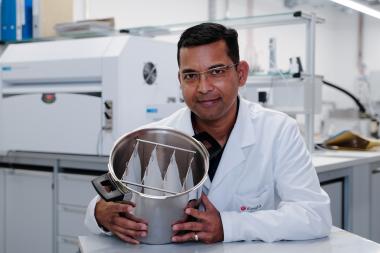Chemist Unlocks Plastic Alternatives Using Proteins and Clothing Scraps
Challa Kumar has developed methods to create novel plastic-like materials using proteins and fabric.
Every year, 400 million tons of plastic waste are generated worldwide. Between 19 and 23 million tons of that plastic waste makes its way into aquatic ecosystems, and the remaining goes into the ground. An additional 92 million tons of cloth waste is generated annually.
Challa Kumar, professor emeritus of chemistry, “fed up” with the tremendous amount of toxic waste people continually pump into the environment, felt compelled to do something. As a chemist, doing something meant using his expertise to develop new, sustainable materials.
“Everyone should think about replacing fossil fuel-based materials with natural materials anywhere they can to help our civilization to survive,” Kumar says. “The house is on fire, we can’t wait. If the house is on fire and you start digging a well – that is not going to work. It’s time to start pouring water on the house.”
Kumar has developed two technologies that use proteins and cloth, respectively, to create new materials. UConn’s Technology Commercialization Services (TCS) has filed provisional patents for both technologies.
Inspired by nature’s ability to construct a diverse array of functional materials, Kumar and his team developed a method to produce continuously tunable non-toxic materials.
“Chemistry is the only thing standing in our way,” Kumar says. “If we understand protein chemistry, we can make protein materials as strong as a diamond or as soft as a feather.”
The first innovation is a process to transform naturally occurring proteins into plastic-like materials. Kumar’s student, Ankarao Kalluri ’23 Ph.D., worked on this project.
Proteins have “reactor groups” on their surfaces which can react with substances with which they come into contact. Using his knowledge of how these groups work, Kumar and his team used a chemical link to bind protein molecules together.
This process creates a dimer – a molecule composed to two proteins. From there, the dimer is joined with another dimer to create tetramer, and so on until it becomes a large 3D molecule. This 3D aspect of the technology is unique, since most synthetic polymers are linear chains.
This novel 3D structure allows the new polymer to behave like a plastic. Just like the proteins of which it is made, the material can stretch, change shape, and fold. Thus, the material can be tailored via chemistry for a variety of specific applications.
Unlike synthetic polymers, because Kumar’s material is made of proteins and a bio-linking chemical, it can biodegrade, just like plant and animal proteins do naturally.
“Nature degrades proteins by ripping apart the amide bonds that are in them,” Kumar says. “It has enzymes to handle that sort of chemistry. We have the same amide linkages in our materials. So, the same enzymes that work in biology should also work on this material and biodegrade it naturally.”
In the lab, the team found that the material degrades within a few days in acidic solution. Now, they are investigating what happens if they bury this material in the ground, which is the fate of many post-consumer plastics.
They have demonstrated that the protein-based material can form a variety of plastic-like products, including coffee cup lids and thin transparent films. It could also be used to make fire-resistant roof tiles, or higher-end materials like, car doors, rocket cone tips, or heart valves.
The next steps for this technology are to continue testing their mechanical properties, like strength or flexibility, as well as toxicity.
“I think we need to have social consciousness that we cannot put out materials into the environment that are toxic,” Kumar says. “We just cannot. We have to stop doing that. And we cannot use materials derived from fossil fuels either.”
Kumar’s second technology uses a similar principle, but instead of just proteins, uses proteins reinforced with natural fibers, specifically cotton.
“We are creating a lot of textile waste each year due to the fast-changing fashion industry” Kumar says. “So why not use that waste to create useful materials – convert waste to wealth.”
Just like the plastic-like protein materials (called “Proteios,” derived from original Greek words), Kumar expects composite materials made from proteins and natural fibers will biodegrade without producing toxic waste.
In the lab, Kumar’s former student, doctoral candidate Adekeye Damilola, created many objects with protein-fabric composites, which include small shoes, desks, flowers, and chairs. This material contains textile fibers which serve as the linking agent with the proteins, rather than the cross-linking chemical Kumar uses for the protein-based plastics.
The crosslinking provides the novel material with the strength to withstand the weight that would be put on something like a chair or a table. The natural affinity between fibers and proteins is why it’s so hard to get food stains out of clothing. This same attraction makes strong protein-fabric materials.
While Kumar’s team has only worked with cotton so far, they expect other fiber materials, like hemp fibers or jute, would behave similarly due to their inherent but common chemical properties with cotton.
“The protein naturally adheres to the surface of the protein,” Kumar says. “We used that understanding to say ‘Hey, if it binds so tightly to cotton, why don’t we make a material out of it.’ And it works, it works amazingly.”
With the support of TCS, Professor Kumar is currently seeking industry partners to bring these technologies to market. For more information contact Michael Invernale at michael.invernale@uconn.edu.
Anna Zarra Aldrich '20 (CLAS), Office of the Vice President for Research












